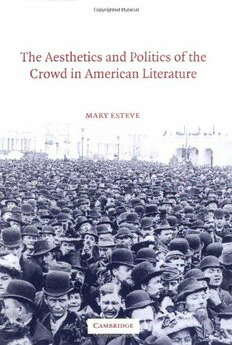
The Aesthetics and Politics of the Crowd in American Literature PDF
274 Pages·2003·1.408 MB·English
Most books are stored in the elastic cloud where traffic is expensive. For this reason, we have a limit on daily download.
Preview The Aesthetics and Politics of the Crowd in American Literature
Description:
Mary Esteve provides a study of crowd representations in Americanliterature from the antebellum era to the early twentieth century. Asa central icon of political and cultural democracy, the crowd occupiesa prominent place in the American literary and cultural landscape.Esteve examines a range of writing by Poe, Hawthorne, Lydia MariaChild,Du Bois, James, and Stephen Crane among others. These writers,she argues, distinguish between the aesthetics of immersion in acrowd and the mode of collectivity demanded of political-liberal subjects.In their representations of everyday crowds, ranging fromstreamsof urban pedestrians to swarms of train travellers, from upper-classparties to lower-class revivalist meetings, such authors seize on thepolitical problems facing a mass liberal democracy – problems such asthe stipulations of citizenship, nation formation, mass immigration,and the emergence of mass media. Esteve examines both the aestheticand political meanings of such urban crowd scenes.
See more
The list of books you might like
Most books are stored in the elastic cloud where traffic is expensive. For this reason, we have a limit on daily download.
